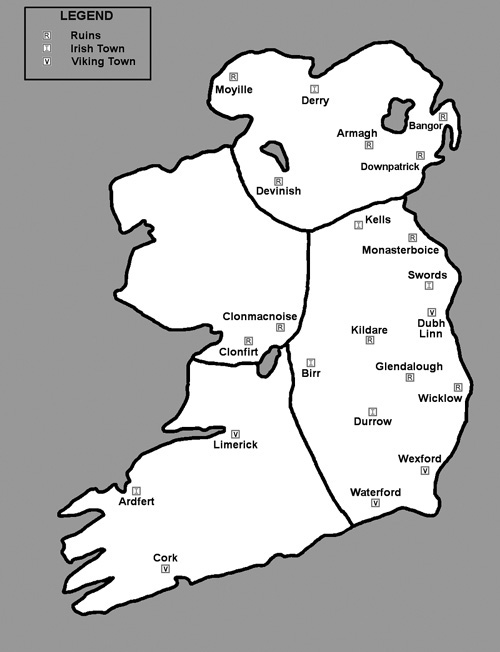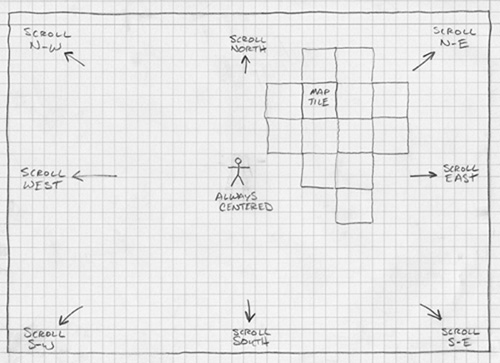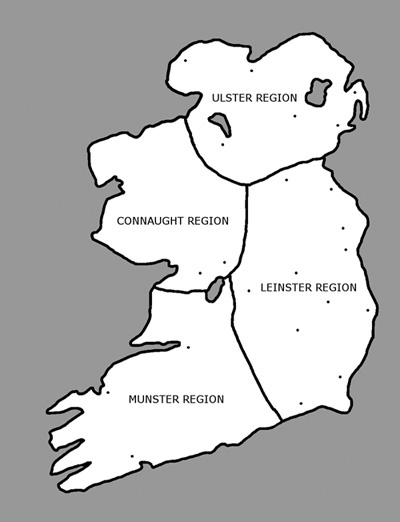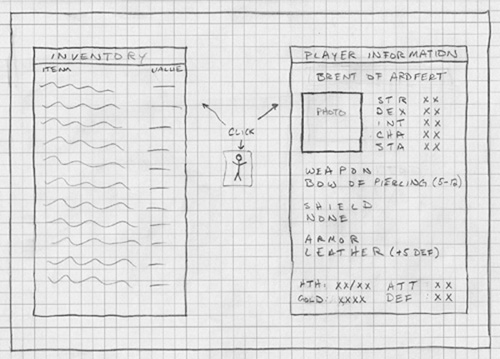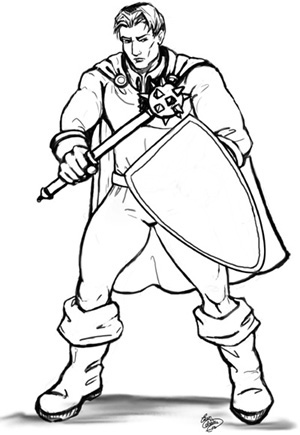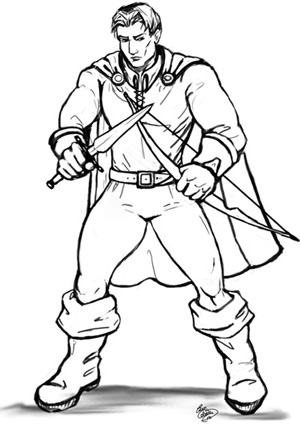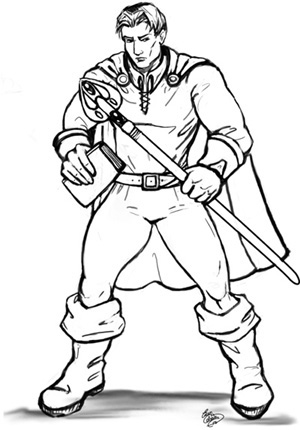In this chapter, we will design the game world featured in Celtic Crusader. Designing a game is no simple task, and it should not be thrown together after the source code has been nearly completed. The design should direct what code gets written and what the game world looks like. I have written several successful game design documents, and they are very valuable to the development team on a game project. In this chapter we will merely design the game world and describe how the game will be played rather than creating an entire design doc. Here’s what we’ll cover in this chapter:
You can learn a lot about your subconscious motivations and creative impulses by designing a game with pencil and paper. I get so much enjoyment out of the design process that my enthusiasm gets the best of me and I want to jump into the code and start writing the game! At the same time, I enjoy drawing even though I have no talent.
Hint
For a complete discussion of how to design a role-playing game, see Swords & Circuitry: A Designer’s Guide to Computer Role-Playing Games(Thomson Course PTR, 2002) by Neal and Jana Hallford. I also recommend Character Development and Storytelling for Games (Thomson Course PTR, 2004) by Lee Sheldon, if you are interested in learning how to create realistic storylines and characters for your games.
It’s important to put as much on paper as possible before you start writing source code. It is good to get started on the artwork for a game while developing the design, because that helps you realize what is possible and somewhat helps with the creative process. If you start working on a game without any design at all, at worst it ends up being left unfinished, at best it is a clinical game (meaning it is functional but lacks substance).
Celtic Crusader is based in ninth-century Ireland, a country occupied by Norwegian Vikings, who ruled the seas at the time. The Vikings were not just barbarous raiders, although this game’s story is about Viking occupation in Ireland and generally depicts Vikings as the bad guys. The Viking civilization was spread across a much wider area than even the Roman Empire, although it was not as strong and it was not based entirely on military conquest. The Vikings were explorers and traders who settled lands, such as Iceland and Greenland, that had never before been visited by humans. Although humans had migrated to North and South America before this time, the Vikings are also credited as being the first Europeans to discover and settle North America. (Actually, the Viking settlers in Greenland were the first Canadians.)
The storyline is usually not as important as the quests that move the story forward. Your character does not have a specific goal, because nothing in life is that clearly defined. Instead, the game develops while your character develops, mainly by fighting animals and fantasy creatures, as well as the occasional Viking raiding party. Your character’s attributes determine how good he is in combat. (See “The Player’s Character” section later in this chapter.) In Celtic Crusader, we’re building both an adventure and a “hack-and-slash” game that may be compared with Diablo and Baldur’s Gate. There are more complex adventure-based RPGs as well (such as The Elder Scrolls and Might & Magic series), and they tend to take a very long time to finish.
The game world in Celtic Crusader is based on the island country of Ireland. I chose this land because it has a rich mythology going back more than 2,000 years, providing a huge pool of possible plot elements for the storyline and sub-quests in a game. I thought of basing the game on ancient America, designing a game around the Mayan or Incan civilizations, but decided to go with Ireland because it is easier to write a story around an isolated community. That also makes it possible to set boundaries on the game map limiting the player’s movement (as opposed to putting mountains or some sort of no-man’s land at the boundary of a land-locked game world).
There is a lot to be said for a randomly generated world or a world based on a completely fictional land with no historical basis. It allows you (the game’s designer) to let loose with your imagination to create a world that does not influence, nor is affected by, the “real world.” Generating a random world is definitely possible, but I don’t like the random factor because it prevents me from designing the game around real locations in the world. Celtic Crusader has characters that are from specific towns based on character class, and I want those towns to be real places on the map, not just generated locations in a random world. The goal is to build a game that has a lot of replay value by offering strong character development rather than anonymous random combat. The fact of the matter is most people love a good story. Giving your game a good story with believable characters makes it far more fun to play than a randomly generated world, even if the same characters appear in that fictional world. Even a great game franchise like World of Warcraft suffers from the animatronic-like affect of scripted, repeating events.
Figure 9.1 shows the map of the world in Celtic Crusader as a traditional hand-drawn illustration. This rough sketch represents Ireland in the ninth century, when the Vikings invaded England and Ireland from their empire in Norway, Denmark, and Sweden.
This map shows Viking towns (a V inside a square), Irish towns (an I inside a circle), and ruins (an R inside a triangle), to give you an idea about how quests are based on the game world itself rather than by some random quest-generation system. In reality, I have taken some creative liberties with the true historical significance of the towns shown in this map. The Irish “towns” were, in reality, monasteries that the Vikings either did not discover or did not plunder for one reason or another. The ruins shown on the map are, in fact, monasteries that the Vikings had plundered by stealing all gold, silver, and valuables they could find. I thought the idea of a plundered monastery lent itself well to a ruin filled with evil creatures. The ruins in Celtic Crusader are based somewhat on historical fact, which I believe really helps with the story, with the idea being that the plundered monasteries, by becoming ruins, have been invaded by vile monsters that are not generally found elsewhere in the game.
The ruins are basically a training ground where the player’s character gains experience, goes up in levels, and acquires gold to buy better equipment in the towns. The goal with this game engine is to have certain parts of the map load a new map via a portal, with the player inserted into a certain part of the new map. (We’ll discuss issues like this when building the Level Editor in the next chapter.) However, I have found that this is a very difficult thing to do without causing the source code to grow in complexity (and I want to keep this game on the simple side). Therefore, the towns in the game world are represented on the map itself rather than as a warp type of system that enters and exits the towns. I really like this idea better because it keeps the suspension of disbelief going.
Definition
Suspension of disbelief is a term that describes one’s immersion in a fictional setting. You may have experienced this while reading a good book or playing a good game: You lose track of the real world around you and become totally immersed in the fiction. This is a very good thing to strive for in your game designs, and you should strive to achieve it with every game. Anything that takes away the player’s suspension of disbelief should be removed from the game. A clunky user interface, a difficult combat system, an overload of information on the screen—these all lead to ruining the player’s feeling of total immersion.
By taking the hand-drawn map and scanning it into the computer, I have been able to clean it up and turn it into a digital version of this game’s world. That world is shown in Figure 9.2.
My goal is to teach you how to create an RPG as well as a quest-driven game engine that you can customize to suit your own vision and imagination. I want to give you just enough to get the job done, while avoiding doing everything for you, so you are motivated to improve the game.
While you’re working on a game like this, always consider ways to make whatever you’re working on reusable. If you are constructing a player creation screen, think of ways to make the screen dynamic and flexible, without hard-coding anything specific. It is a good idea to keep things concrete and solidly built in the game, but not to the point where it’s impossible to modify later. If you have buttons on the screen that the player needs to click with the mouse, make those buttons easy to move around—use constants at the top of the source code for that particular screen. Another option is to make everything in your game skinnable. You know, skins are all the rage in user interfaces today, and most music players for your PC support skinning. This is a process where the program controls can be repositioned and the images used to represent those controls can be modified—with some fantastic results. Why not take that excellent design methodology with you in the design of a game and make it totally customizable by storing skins and settings in files outside of the source code for the game? This excellent concept may be beyond the scope of this short book, but I want you to keep it in mind while you are working.
Figure 9.3 shows my admittedly crude mock-up for the scrolling game world. The player’s sprite remains in the center of the screen at all times, with the world scrolling underfoot. With this design in mind, the map has to be laid out so there is room around the borders for the player to reach the edge of the map. In other words, when the player reaches the ocean, the map needs to have ocean squares going out a little so the player can walk right up to the seashore. The eight-way scrolling of the map is perfect for the sprites in this game, which have been rendered with animation in eight directions.
There are four provinces, or regions, in the version of Ireland represented in this game: Leinster, Munster, Connaught, and Ulster (see Figure 9.4). It is not crucial, but I have always found that a background story and historical depth make a game far more compelling for the player, greatly improving the sense of immersion in the game world. A game is not just backgrounds, sprites, and collision detection, and players expect much more depth to an RPG than they expect from an arcade game. One aspect of the Ultima series that made it so popular is the wealth of historical information provided to the player within the game (usually through dialog with NPCs). You want to create the illusion that the player is just one person in a huge, populated world that goes on with or without him. At the start of the game, the player will begin in a town within one of these four regions—depending on the character class chosen—and the history of the region will be reflected in the people that the player will encounter early in the game.
Leinster region, located on the east side of Ireland, is where most of the fighting takes place between the native Irish people (who are, admittedly, descended from Anglo-Saxons in the first place, never mind that the Celts are long gone. . .) and the Viking invaders who created three settlements: Dubh Linn, Wexford, and Waterford. Leinster borders all three of the other regions. The Irish monastery towns include Kells, Swords, Birr, and Durrow. There are also some ruins (pillaged monasteries) in this region: Monasterboice, Kildare, Glendalough, and Wicklow. This region produces the most axe-bearing warriors and sword-wielding paladins in the world.
The Munster region of Ireland, located in the southwest, is adjacent to Leinster and Connaught. Munster is the second strongest region of Viking occupation on Ireland with the two Viking settlements of Limerick and Cork. Although there are no ruins in this region at all, there is one Irish monastery town called Ardfert, which is famous for producing skilled archers (known by the character class scout), the likes of which fought against the Vikings during their initial invasion and occupation. The Vikings have never learned about the secret bow craft of Ardfert, so many patriotic archers are still trained there.
Ulster region, located on the north side of Ireland, is the location for most of the island’s religious artifacts; its inhabitants practice the ancient art of mastering the natural world. Ulster was devastated by the Vikings during their initial invasion, with many mages killed while trying to protect their monasteries. There were vast arrays of gold and silver artifacts given to the mages of Ulster as offerings throughout the generations. Despite mastery of the natural world, Ulster mages were peaceful in nature and abhorred violence of any kind, even in one’s defense. As a result, the mages of Ulster were defenseless against an unknown enemy that brought brutality to the region, plundering the monasteries of Moyille, Devenish, Armagh, Downpatrick, and Bangor, leaving them in ruins. Only Derry remained unscathed by the plundering. The tenants of Derry, the last vestige of Celtic mages left alive, have been forced to abandon their prior unity with the natural world and focus their attention on combat in order to drive out the Viking invaders. Mages of Derry are masters of the staff in hand-to-hand combat and are able to wield some of the unseen forces of the world to aid them in battle.
The Connaught region is located on the western side of Ireland. Connaught was once a vast grazing land for cows, sheep, and goats, with its wide open plains and plentiful feeding ranges. Connaught is not a widely settled region, though, and the Viking invasion rallied those few living in Connaught to the battle in defense of the land. The result is that forests have grown into Connaught from the south, and it is mainly a breeding ground for evil creatures and a hiding place for criminals. Two monasteries in southern Connaught—Clonmacnoise and Clonfert—were pillaged by the Vikings, who left them in ruins. The inhabitants of these two ruins are a constant nuisance to the hardworking citizens of Birr, located nearby in Leinster region.
One of the most enjoyable aspects of playing an RPG is creating your very own custom character to use in the game. This is why true RPGs have more depth and more replay value than games featuring a specific set of characters (as in the Zelda series). Because player character creation is so much a part of the experience, it’s important to design the character creation screen with as much versatility as possible so the player can create his or her own persona for the game. Celtic Crusader is taking shape as an old-school RPG, and will eventually allow you to design your own character from scratch. The game should allow your character to interact within the confines of the main storyline of the game (as well as within the sub-quests). Figure 9.5 shows one possible design for a character creation screen. This is a very crude drawing, but it should give you an idea of what you might do for your own character screen.
Hint
To see what the final character generation screen looks like, jump ahead to Chapter 20 to check it out! It’s not exactly like the design, but comes close to it.
All characters in the game—including non-player characters and monsters—have the same set of attributes in order to make combat possible: strength, dexterity, stamina, intellect, and charisma.
Strength (STR) represents the character’s ability to carry a weight and swing a weapon, and is generally good for the warrior and knight classes, which carry hand-to-hand combat weapons, such as axes and swords. The strength attribute is used to calculate the attack value for the character (meaning, the amount of damage the player inflicts on enemies with each swing of a weapon). Each time the character attacks, a dice roll (which is a random number in code) against the attack value determines whether the attack succeeds. If the attack is a hit, then the weapon’s damage value is used to inflict damage against the opponent. Suppose your character has an attack value (ATT) of 12, which is calculated using the character’s strength (mainly, although you may include dexterity in a custom calculation to make the game more interesting). Typical “attack rolls” are done with a D20 (a 20-sided die). In a Visual Basic program, you can simulate the roll of dice using the Random class. An attack value of 12 will go up against the other player’s defense value to determine if any damage is dealt.
Dexterity (DEX) represents the agility of the character, the ability to manipulate objects (such as a weapon), and the skill with which the player uses his or her hands in general. A very low dexterity means the character is clumsy, while a very high dexterity means the character can manipulate complicated devices and perform fast, complex actions. Use of any weapon (such as a sword, a mace, or even a bow) is improved with a high dexterity, and a high skill might even allow the character to wield two weapons at once (dual wield).
Stamina (STA) represents a character’s endurance, or the ability to continue performing an activity for a long period of time. Stamina is also known as constitution in some RPGs. A very high stamina provides a character with the ability to engage in lengthy battles without rest, while a character with low stamina tires quickly (and likely falls in battle). Stamina affects the player’s total number of hit points (HP).
Intellect or Intelligence (INT) represents the character’s ability to learn, remember things, and solve problems. The mage class requires a very high intellect, while relatively low intellect is common in melee combat classes that favor brute force over mental faculties. The intellect usually affects a player’s ability to learn magic spells and perform spell-casting.
Charisma represents the character’s attractiveness and appearance, and generally affects how others respond to the character. A character with very high charisma attracts others, while one with very low charisma shuns others. Knights usually have very high charisma, reflecting their heroic stature, while Wizards often have a lower charisma since they are not as concerned with appearances.
When the character is represented in the game with a sprite, you want the player to be able to view the information about his or her character by bringing up some sort of status screen, as is the norm with most RPGs. Figure 9.6 shows an example screen that I designed to show the player’s stats in a sort of pop-up window over the game screen. The window shows information about the player such as attributes, equipment, health, gold, and so on.
Hint
Likewise, to see what the final inventory screen looks like, jump ahead to Chapter 18 and compare the final result with this early design!
This screen design also has one possible way of handling inventory management in the game. Since inventory is such a huge and complex issue, we’ll be devoting two chapters to it in Part III. I’ve played games where inventory was so time consuming and required so much micro-management that it ruined my suspension of disbelief while playing the game. Realistically, if you are a soldier of one class or another, do you have the strength to carry 100 swords, shields, and suits of armor while also carrying 1,000 arrows and 250 rings? Some RPGs are that ridiculous. A limited form of inventory management is definitely needed. We will be creating an item editor in Chapter 17 and working an inventory manager into the game in Chapter 18.
I like how Peter Molyneux designed an intuitive inventory system for the game Fable. In Fable, your character can carry quite a lot of stuff, because there is a fascinating aspect of this game that allows you to become a trader, making money by buying and selling goods. But with respect to combat gear, the game automatically recognizes “suits” of related armor items so you can auto-equip all related items of armor at once. I could literally go on for pages describing this amazing game. One thing that caused me to fall off my seat with laughter was what happened to my character when I equipped him with a very heavy hammer weapon. The game accurately modeled the character dragging the hammer behind him, and he was barely able to swing it!
Each character class comes from a certain part of the world, where it is assumed that the raw materials and skills are available for that class. For instance, sword masters come from the Irish towns within the region of Leinster. There is no real reason for this historically, but I just like the idea of certain character classes coming from different parts of the world. Table 9.1 shows the character classes and their home regions. The two fighter classes—warrior and paladin—both originate in Leinster. In reality, a character might be born anywhere, but is located in one of the towns in a certain region when the character is created. In the context of the game, creating a character means simply that you, as the player, are finding and assuming the identity of someone in the fictional world (or rather, someone of whom you are taking control).
Table 9.1. Home Regions for Possible Character Classes
Character Class | Region |
|---|---|
Warrior | Leinster |
Paladin | Leinster |
Hunter | Munster |
Priest | Ulster |
There are no towns in the region of Connaught (only two ruins), so no characters can originate from this region. This is generally going to be a chaotic region ruled by anarchy, populated with thieves, cutthroats, and evil creatures aplenty. The character attribute modifiers for each class are based on a fixed set of 15 points distributed among the attributes to reflect that class’ strong and weak characteristics. If you add the modifiers together they equal 15, no matter the class, so there is no numerical advantage of one class over another. These base attributes are essential to defining each class. You should feel free to change this numerical basis for your own vision for this game. Just be sure to start off the base character classes with low “stats”—you don’t want the player to become too strong early in the game.
Warriors originate in the Leinster region due to the ongoing conflict with the Vikings, which have the strongest presence in all of Ireland. (There are three Viking settlements: Dubh Linn, Wexford, and Waterford.) It does make sense, if you think about it, because where there is the greatest conflict there is likely to be the most surplus of weapons available. A character in this region should be able to find a weapon and begin training—and there is the added possibility that a character was formerly an Irish patriot in a defeated and disbanded army.
Figure 9.7 shows an example of a concept drawing of a Viking warrior.
Warriors can wield any type of heavy weapon but are basically limited by the available artwork, meaning that the warrior in this game carries an axe. Warriors have the attribute modifiers detailed in Table 9.2.
Table 9.2. Warrior Attribute Modifiers
Attribute | Modifier |
|---|---|
Strength | +8 |
Dexterity | +3 |
Intellect | 0 |
Charisma | 0 |
Stamina | +4 |
Hint
For the final design of the game characters, including the final attribute modifiers with combat modifiers, refer to Chapter 14, “Creating the Character Editor.”
Paladins are holy warriors who pledge their loyalty to God and country, so to speak, although this has been fantasized in literature and fantasy gaming to mean that knights have certain magical capabilities (notably the ability to heal others). It is generally accepted that a knight in an RPG should always defend good and fight against evil. You should never have an evil knight (otherwise, you should just create a character from another class), although it might be possible to have a “dark knight” who has become corrupted, which is an interesting story element.
Figure 9.8 shows a concept drawing of a paladin. You can see from this single drawing that concept artwork is extremely valuable, as it helps to fully realize the potential of the game and gives the sprite artist an example of what the sprite should look like. When you have 100+ frames of animation for a sprite, you want to be sure that it is correct on the first frame because animation is very difficult to modify after the artist has completed the work.
In this game, I loosely define a paladin as a character wielding any type of weapon as long as he also has a shield. Paladins are well-rounded characters, with the character attribute modifiers in Table 9.3, with a strong emphasis on survivability due to a high stamina value. When we work on the character editor in Chapter 14, you will be able to define your own classes for the player, NPCs, and monsters, so consider these just common examples.
Hunters are common in the land of Ireland since the bow is the most common hunting weapon in the world. However, the military-caliber archer is only found in one place: the forest-encroached Irish town of Ardfert, the only unscathed Irish settlement in the region of Munster. The craft of building bows and carving straight arrows may be found throughout the land, but the craft of building armor-piercing arrows and multi-string compound bows is now limited exclusively to Ardfert. The skilled archers of Ardfert are themselves as skilled in bowcraft as they are in warcraft, often recruited by Irish militia at the outlying towns and by rebel factions still fighting against the Vikings. Figure 9.9 shows a concept drawing of a hunter character. The attribute modifiers for the scout class are given in Table 9.4.
The priests of Ulster region were once peaceful caretakers of Ireland’s monasteries, turning their attention to a mastery of the natural world, including the use of healing herbs and cultivating gardens. The invasion of the Vikings and subsequent pillaging of monasteries left many of the mages slaughtered, and those remaining fled to the few monasteries that were not discovered by the Vikings. Those who were left refocused their attention on righteous combat techniques, making the priests of Ulster skilled in hand-to-hand combat as well as in using holy attacks. In addition, priests still know the art of healing. Table 9.5 reveals the attribute modifiers for the priest class.
Table 9.5. Priest Attribute Modifiers
Attribute | Modifier |
|---|---|
Strength | 0 |
Dexterity | +6 |
Intellect | +8 |
Charisma | 0 |
Stamina | +1 |
Figure 9.10 shows an artist’s concept drawing of a priest character. What is the most significant thing that you notice about the concept drawings? They are hand-drawn, often in pencil, and scanned, rather than edited in a graphic editor program. Even if you have some fantastic character models already available for your game (that you plan to render into animated sprites), your game will still benefit greatly from hand-drawn concept renditions of each character.
Non-player characters (NPCs) represent everyone in the world other than the player’s character (and the party in a game with more than one person playing, as in multiplayer games). NPCs are usually controlled by the game itself using a scripted or behavioral subroutine. Friendly NPCs might be common townsfolk walking around the towns, doing their work and conducting business. NPCs might also be enemies, hostile to the player’s character, who attack the PC on sight. Most of the time, fantasy creatures and monsters are not called NPCs because they are just obstacles that the player must overcome to complete a quest, and they generally help build up the PC’s experience to level and increase his skills.
The NPCs in Celtic Crusader should follow a simple predefined path in the towns and not venture outside the towns in which they are placed. This is accomplished by having them move around only within a limited range from their starting points. So, if the town of Durrow is located at a certain (X,Y) position on the map, then the game generates a certain number of NPCs and places them at the same location identified as that town (along with a small random value, so they aren’t all bunched up). The NPCs then move about in random directions within a close proximity to their original starting points. In many cases, NPCs walk back and forth between two points on the map (a technique called “patrolling”).
This rather simplistic behavior produces a surprisingly realistic town, and you can always insert some NPCs with more advanced behavior necessary to complete a certain quest. But most of the NPCs will simply move around in this manner and make themselves available to the player for dialogue. Each NPC is provided with a simple set of responses to dialogue in which the player can choose to engage (by walking up to an NPC and hitting a button). We will explore the dialogue when creating the character editor and quest editor.
The standard weapons are very weak in combat while the player is just getting started in the first few levels. This is balanced by the levels of creatures and enemy NPCs that the player encounters in the early stages. As the player increases in experience and goes up in levels, the foes are equally challenging to keep the player on edge all the time and to keep the good players from finishing the game too quickly. The player should be able to equip a standard weapon, shield, and armor and automatically swap gear when better items are found (which is not a significant part of the game, so it is not strongly emphasized).
Table 9.6 shows the standard weapons that may be used by each character class. We will create an item editor in Chapter 17 and work on an inventory system in Chapter 18.
Magic is a huge part of most RPGs and adds a lot to the character development aspects of a game. However, I have played many games that emphasize way too much magic, to the point of almost abandoning traditional weapons for offense and defense. In my opinion, magic should be downplayed as much as possible because it has the potential to ruin a story if over-emphasized. When there are hundreds of available magic spells that a character can learn, it tends to become the whole focus of the gameplay, and that’s a shame! The game shouldn’t be totally about character development and becoming the most powerful wizard in the world, although that is exactly what happens with some games.
One way to handle magic is by treating spells as animated projectile sprites with embedded damage modifiers that cause things to happen to the target. For instance, arrows fired by the scout do damage based on the scout’s character attack value, which is affected by the quality of the character’s bow and skill. Several factors determine the possible amount of damage that an arrow can inflict on an opponent, if the opponent doesn’t block the attack. (A strong defense value causes the arrow to miss entirely in some attacks.)
The amount of magic that can be used in an RPG is greatly dependent upon the available artwork to render magic spells used as weapons (such as a fireball). It is better to start off with a limited magic system that allows the mage classes (which you might subclass into cleric, wizard, and so on) to heal themselves and others, as well as to enchant weapons. It is very common for magic in an RPG to grow in usage and depth as the game develops from one sequel to the next. Don’t assume that you absolutely must get every single idea into the game on your first attempt. It’s fun to leave room for growth, and players enjoy the new features of follow-up games in the series.
You might also consider the possibility of marketing a game as shareware, where you freely give away a limited version of the game (which may, for instance, just provide one character class), and then ask fans to pay for the full version, which would have a full assortment of magic spells and other important features.
The communication system in the game is important, but not crucial to a hack-and-slash type of game. Granted, such games are popular and have a lot of fans, but I want to provide you with ample opportunity to customize and improve the game. I don’t want to fix the game to a specific goal (such as defeating a certain boss character), although that is certainly a goal that might be put into the game as one way to win.
Dialogue in most games can take place at the bottom of the screen, where messages are printed out and where the player can choose what to say to the NPCs. Another way to handle dialogue is to display messages in balloon popups over the players, which is often done in controller-based console RPGs. A nice feature to add to the dialogue system is recorded voice acting, although if poorly presented, this can actually take away from the suspension of disbelief. (Always be careful not to do that!) It is sometimes better to just leave the player with his or her imagination, because many RPG fans regularly read fantasy books. We develop a way to communicate with NPCs in Chapter 15, “Dialogue: Talking with NPCs”.
The combat in Celtic Crusader should take place in real time using the same scrolling map game engine used for walking around. The combat system is more challenging when programming NPCs to react realistically to the dynamic environment than to combat itself. The basis for combat is an engagement of weapons using a custom subset of animated sprite frames showing the swinging of a weapon or the shooting of an arrow.
When an attack takes place, the player’s attack value (which is derived from the player’s strength and character levels) is compared to the opponent’s defense value (which is based on strength, shield, and armor), and the result is added to a randomly generated number. If the final result is positive, then the attack succeeded; otherwise, the attack missed. On a successful attack, the amount of damage done by the weapon is rolled (usually a range, such as 5 to 12), and that is how much damage the target takes. The damage reduces the health points of the player or NPC, and the target is killed if health drops below zero. We build a complete stats-based combat system in Chapter 16, “Fighting, Getting XP, and Leveling Up.”
Although game design should be considerably more complete than the partial design provided in this chapter, I think you now have a good idea about how to get started with your own RPG design. This is such a rich and varied genre that a complete and detailed design is not entirely necessary, since we can just borrow from existing (and proven!) design concepts. Drawing what you think each screen should look like and brainstorming gameplay ideas ahead of time makes the game far more interesting when you start writing the source code that actually makes the game work. Without a solid design up front, you are destined to give up on the game before it is finished. In contrast, you will become more and more enthusiastic about the game as you complete the design of each part of the game, because the process opens your mind to the possibilities. This chapter explored just some of the primary aspects of the Celtic Crusader game, giving you a basic idea about how to design a game. Of course we can’t create a completely fleshed-out game in just a book example, but all the pieces are falling into place already.


